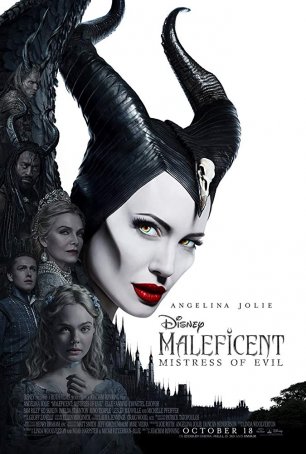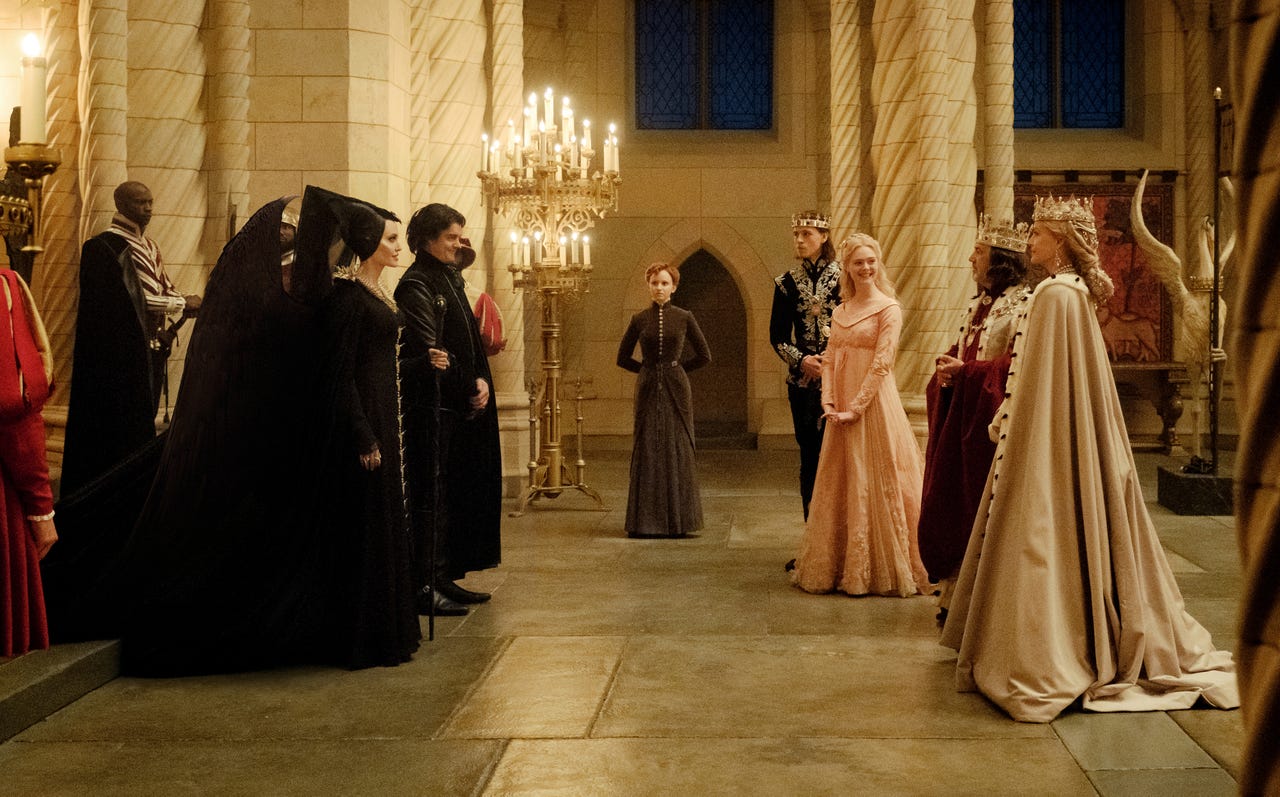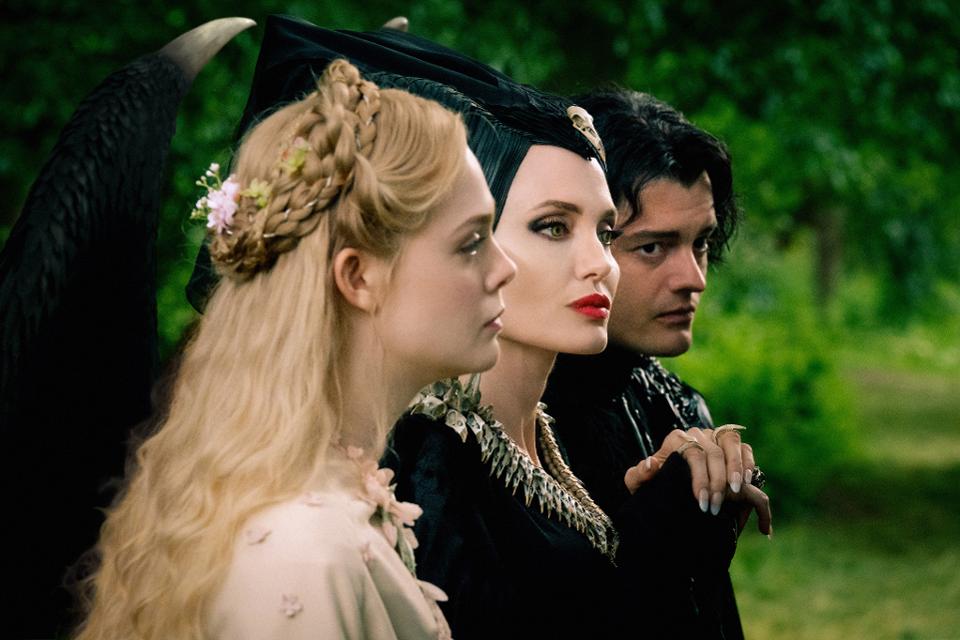Maleficent: Mistress of Evil (United States/United Kingdom, 2019)
October 16, 2019
This review contains (oblique) spoilers.
When Disney released Maleficent in 2014, it was a fresh approach to the Sleeping Beauty story – a live-action re-interpretation of the fairy tale with the supposed villain recast as a sympathetic figure. With Angelina Jolie as Maleficent and Elle Fanning as Sleeping Beauty/Aurora, the movie did well enough at the box office to warrant a sequel. Mistress of Evil is the result and, although the second installment is effective at moving the story forward rather than re-treading familiar ground, it enters a patch of quicksand from which it is unprepared to escape. Disney is adept at doing many things but offering a sobering and intelligent examination of genocide is not among them.
Kids, especially younger ones, may not recognize what’s going on in this film so, to them, Mistress of Evil could simply represent another chapter in the Sleeping Beauty saga. Adults, however, may be surprised when they realize that the plan of Queen Ingrith (Michelle Pfeiffer), a human supremacist leader, is the complete eradication of the Fae. This isn’t evident at first – initially, it’s more about the question of whether the creatures of the Moors and the humans of neighboring lands can live in peace. But, as the story develops, Ingrith’s plan is exposed. The problem with Mistress of Evil isn’t that it addresses the topic of genocide but that the resolution is tone-deaf. Consequences are swept under the rug. The tidy manner in which the film concludes is offensive in its determination not to be offensive. You can’t present an issue as serious as this then wrap it up with everyone singing “Kumbaya.”
 Putting aside the morally dubious conclusion and various
associated problems, Mistress of Evil is reasonably engaging. When the
besotted Queen Aurora and her dimwitted beau, Prince Philip (Harris Dickinson,
replacing Brenton Thwaites, who played the role in Maleficent), decide
to tie the knot, it’s time to tell the parents. Philip’s father, pacifist King
John (Robert Lindsay), is delighted by the potential to form deep ties between
the two kingdoms. His wife, Ingrith, sees the wedding as the next step in her
diabolical scheme. Maleficent is against the union but agrees to attend a
“getting to know you” dinner, which is where the problems begin. Ingrith frames
Maleficent for “cursing” King John (who falls into a coma) and, as the dark
fairy is leaving, she is critically wounded by a steel bullet fired from a
crossbow. She is rescued from a watery grave by one of her own, the heroic Conall
(Chiwetel Ejiofor), and is brought to a secluded hideout where she can recover
and decide whether she favors peace or war. Meanwhile, Ingrith prepares not
merely for battle but for the eradication of all non-humans. Philip remains
oblivious to his mother’s plotting but Aurora, concerned about Maleficent’s
seeming betrayal and subsequent disappearance, begins to doubt the wisdom of
some of her choices and the sincerity of her future mother-in-law.
Putting aside the morally dubious conclusion and various
associated problems, Mistress of Evil is reasonably engaging. When the
besotted Queen Aurora and her dimwitted beau, Prince Philip (Harris Dickinson,
replacing Brenton Thwaites, who played the role in Maleficent), decide
to tie the knot, it’s time to tell the parents. Philip’s father, pacifist King
John (Robert Lindsay), is delighted by the potential to form deep ties between
the two kingdoms. His wife, Ingrith, sees the wedding as the next step in her
diabolical scheme. Maleficent is against the union but agrees to attend a
“getting to know you” dinner, which is where the problems begin. Ingrith frames
Maleficent for “cursing” King John (who falls into a coma) and, as the dark
fairy is leaving, she is critically wounded by a steel bullet fired from a
crossbow. She is rescued from a watery grave by one of her own, the heroic Conall
(Chiwetel Ejiofor), and is brought to a secluded hideout where she can recover
and decide whether she favors peace or war. Meanwhile, Ingrith prepares not
merely for battle but for the eradication of all non-humans. Philip remains
oblivious to his mother’s plotting but Aurora, concerned about Maleficent’s
seeming betrayal and subsequent disappearance, begins to doubt the wisdom of
some of her choices and the sincerity of her future mother-in-law.
One of the strengths of Robert Stromberg’s Maleficent was the world-building. Although director Joachim Ronning’s approach isn’t as deft, the film nevertheless has a strong visual appeal. The fairy creatures are effectively rendered and the settings vary from the magically effervescent to the dank and dreary. The movie offers one truly remarkable sequence near the beginning when the camera spins 360 degrees and soars. Sensitive viewers may experience a momentary disorientation as a result of this shot.
 Angelina Jolie doesn’t bring much more to the role than she
did in Maleficent. The actress does her best work when Maleficent’s evil
side emerges – Jolie is better at playing bad than kind and sympathetic. Elle
Fanning, who was charming in the first movie, is stuck in the thankless “damsel
in distress” role. Michelle Pfeiffer shows that she has the chops to be a truly
detestable villain. She embodies the parable that beauty is skin-deep but ugly
goes all the way to the soul.
Angelina Jolie doesn’t bring much more to the role than she
did in Maleficent. The actress does her best work when Maleficent’s evil
side emerges – Jolie is better at playing bad than kind and sympathetic. Elle
Fanning, who was charming in the first movie, is stuck in the thankless “damsel
in distress” role. Michelle Pfeiffer shows that she has the chops to be a truly
detestable villain. She embodies the parable that beauty is skin-deep but ugly
goes all the way to the soul.
Is it valid to dismiss the film’s blasé approach to genocide by claiming that “it’s only a fairy tale?” Is it a defense that few under the age of 12 will recognize the dark allegorical aspects? Mistress of Evil makes a conscious decision to address a subject that not many family films would touch with a ten-foot pole…then bungles the implications and the message. When one takes a look at how many morally questionable positions the film adopts in order to achieve its happy ending, it raises questions not only about the movie’s ethics but whether the filmmakers are aware of their infractions.
Maleficent: Mistress of Evil (United States/United Kingdom, 2019)
Cast: Angelina Jolie, Elle Fanning, Michelle Pfeiffer, Harris Dickinson, Sam Riley, Chiwetel Ejiofor, Ed Skrein, Robert Lindsay
Home Release Date: 2020-01-14
Screenplay: Micah Fitzerman-Blue, Noah Harpster, Linda Woolverton
Cinematography: Henry Braham
Music: Geoff Zanelli
U.S. Distributor: Walt Disney Pictures
U.S. Release Date: 2019-10-18
MPAA Rating: "PG" (Violence)
Genre: Fantasy
Subtitles: none
Theatrical Aspect Ratio: 2.35:1
- Princess Bride, The (1987)
- Lord of the Rings, The: The Fellowship of the Ring (2001)
- Lord of the Rings, The: The Two Towers (2002)

Comments